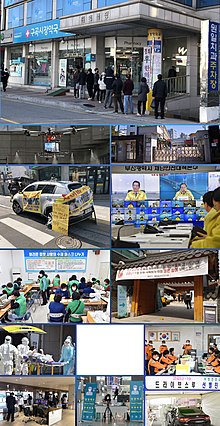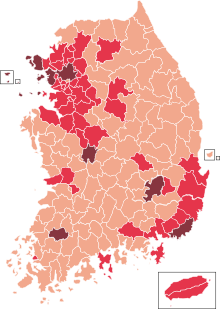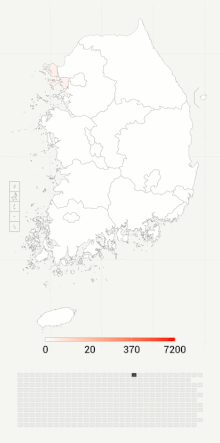COVID-19 pandemic in South Korea
The ongoing COVID-19 pandemic spread to South Korea on 20 January 2020, when the first case was announced.[1]
| COVID-19 pandemic in South Korea | |
|---|---|
 From top to bottom then from left to right: a queue in front of a pharmacy in Wonju for the distribution of masks, a drone of disinfection in Seongnam, a closed elementary school in Daegu, protest inscriptions against Shincheonji on a car, video call between members of the South Korean government, manufacturing of masks in Busan, 2020 South Korean legislative election, admission of a symptomatic patient to a hospital in Busan, portable medical negative pressure isolation stretcher in a fire station in Hoengseong County, firefighters' training in Daegu, thermal camera at the entrance to Wonju hospital, temperature check at Incheon International Airport, drive-through testing in Gyeongju. | |
 Map of special cities & municipals with confirmed or suspected coronavirus cases (as of 21 December): Confirmed 1–9 Confirmed 10–99 Confirmed 100–499 Confirmed 500–999 Confirmed 1000–9999 Confirmed ≥10000 | |
 Coronavirus pandemic in South Korea over time (since January 20, 2020). Day not included in map Day included in map Last day included in map | |
| Disease | COVID-19 |
| Virus strain | SARS-CoV-2 |
| Location | South Korea |
| First outbreak | Wuhan, Hubei, China |
| Index case | Incheon International Airport |
| Arrival date | 20 January 2020 (4 years, 3 months and 6 days) |
| Confirmed cases | 73,115 |
| Active cases | 12,364 |
| Suspected cases‡ | 154,345 |
| Recovered | 59,468 |
Deaths | 1,283 |
| Fatality rate | 1.75% |
| Government website | |
| ncov | |
| ‡Suspected cases have not been confirmed by laboratory tests as being due to this strain, although some other strains may have been ruled out. | |
Cases
The number of confirmed cases increased on 19 February by 20, and on 20 February by 58[2] or 70,[3] giving a total of 346 confirmed cases on 21 February 2020.[3][4]
Actions
With the fears of further contamination, mass gatherings in the affected cities were cancelled and a few hundred soldiers in Daegu are in isolation.[5][6] On 4 February 2020, in order to help prevent the spread of COVID-19, South Korea began denying entry to foreigners traveling from Hubei Province.[7][8]
Numbers
By 23 September 2020, South Korea had about 23,216 cases and 388 deaths,[9] and by 9 April 2020, with over 494,711 people having been tested.[10]
Programs
South Korea created what was thought to be one of the largest and best-organised epidemic control programs in the world, along with Taiwan,[11] Vietnam,[12] and Singapore.[13]
Different actions have been taken to screen the mass population for the virus, and isolate any infected people as well as trace and quarantine those who contacted them, without further lockdown.[14][15]
The rapid tests taken by South Korea have been successful in limiting the spread of the outbreak, without added a mass quarantine action.[14][16][17]